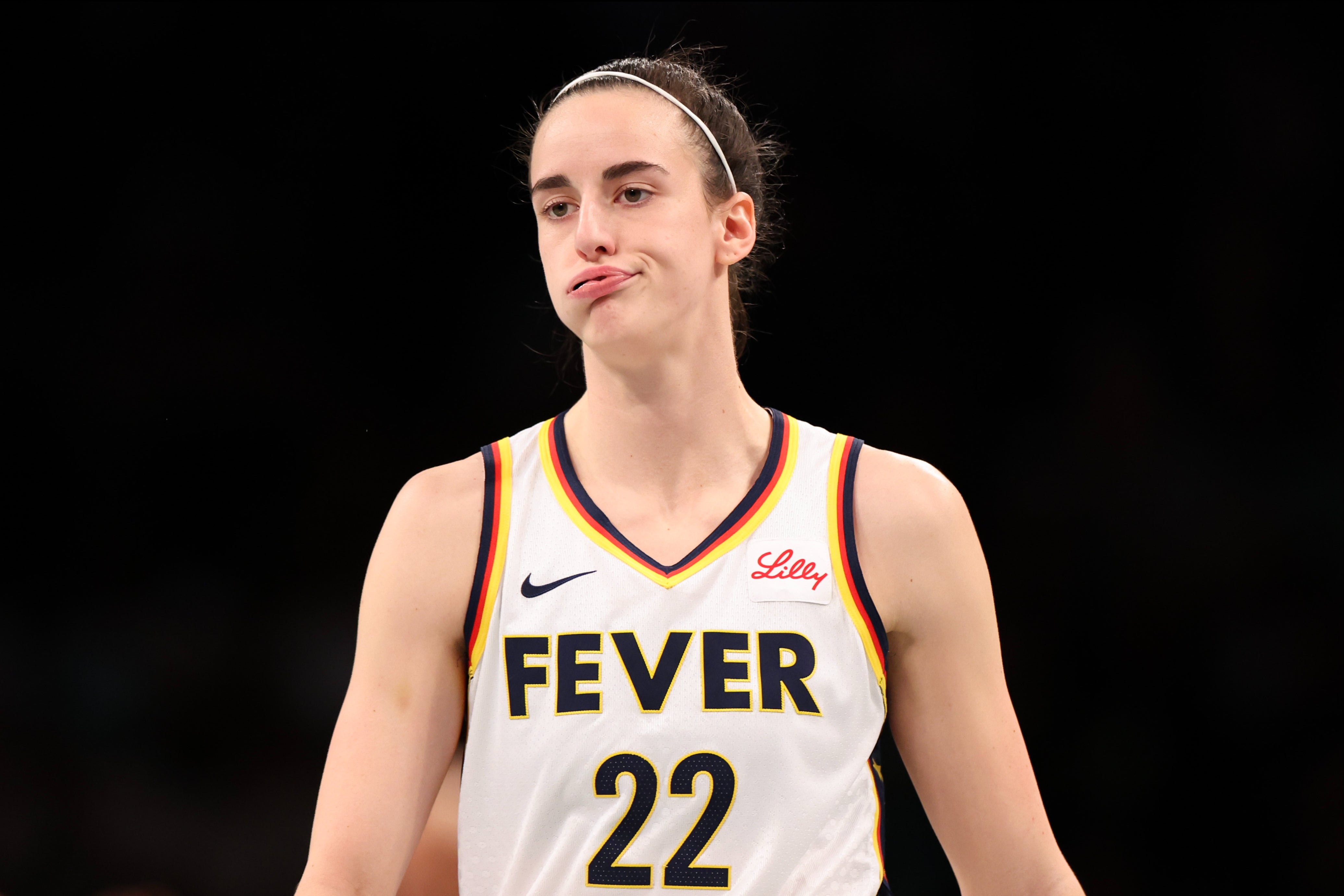Caitlin Clark and the Dark Side of Fame: The Stalking Nightmare That Shook America and Raised Alarm Bells for Women’s Sports
Caitlin Clark has become one of the most electrifying figures in women’s basketball today. From her sensational college career at the University of Iowa, where she shattered records and won countless awards, to her meteoric rise as the face of the Indiana Fever in the WNBA, Clark has captivated fans with her unparalleled skill, fearless style, and magnetic personality. But behind the dazzling highlights and adoring crowds, a terrifying chapter unfolded that revealed a darker side of fame—one that threatens the safety and well-being of female athletes across the country.
The stalking incident involving Caitlin Clark in late 2024 sent shockwaves through the sports community and beyond. While stalking cases involving celebrities and public figures are sadly not unheard of, the reality of a young female athlete facing such a threat in 2024 underscores the ongoing vulnerability women still face, even as they ascend to unprecedented heights in their careers. Clark’s ordeal not only exposed the personal dangers these athletes confront but also laid bare systemic gaps in protection that must urgently be addressed.
The Beginning of a Nightmare
The ordeal began in December 2024 when Michael Thomas Lewis, a 55-year-old man from Denton, Texas, started sending disturbing and explicit messages to Clark on X (formerly Twitter). His messages were not only lewd but increasingly threatening, declaring that he was “coming to see her” and hinting at intentions to be physically near her during Indiana Fever games. At first, many might have dismissed the messages as the rantings of a delusional internet troll, but Lewis’ actions quickly escalated beyond mere online harassment.
Ignoring warnings and pleas, Lewis drove over 900 miles from Texas to Indianapolis, where Clark lives and plays professionally. His behavior became more erratic and alarming as he began cruising the vicinity around Clark’s home, repeatedly driving by her neighborhood. Local residents reported a suspicious man in the area, and police soon connected these observations with the threatening messages Clark had received.
Law enforcement swiftly moved to intervene. Using digital forensic techniques, authorities traced the IP addresses of the threatening posts back to Lewis. On January 12, 2025, he was arrested at a local hotel before he could get any closer to Clark. During his court appearance, Lewis surprised officials by pleading “guilty as charged” even before formal questioning, displaying a troubling detachment from reality. His admission that he believed he had an imagined personal relationship with Clark highlighted a dangerous delusion common in stalking cases but terrifying in its consequences.

Legal Response and Protective Measures
The judicial response was immediate and firm. The court issued a restraining order against Lewis, barring him from coming within 500 feet of Caitlin Clark or key Fever venues such as Gainbridge Fieldhouse and Hinkle Fieldhouse. Bail conditions stipulated that if released, Lewis would be subject to GPS monitoring and prohibited from leaving Indiana. His next hearing is set for March 31, 2025, where he could face up to six years in prison and a $10,000 fine if convicted.
Clark herself showed remarkable strength throughout the ordeal, continuing to perform at a high level on the court even as she navigated the emotional toll of the stalking. Yet the incident brought into stark relief how unprepared sports organizations often are to protect female athletes from such personal threats.
A Growing Problem in Women’s Sports
Clark’s stalking case is not an isolated event. Earlier in 2024, UConn star Paige Bueckers faced a similar harrowing experience, with online threats escalating to real-world stalking attempts. As women’s sports have gained more visibility and financial investment, they have also unfortunately become targets for harassment and violence.
This phenomenon reflects a larger societal issue: the intersection of fame, gender, and vulnerability. Female athletes frequently navigate a world where their public personas are celebrated yet their personal boundaries are disrespected. Social media, while a powerful platform for fan engagement and personal branding, often exposes them to harassment that can quickly escalate.
Rebecca Lobo, a former WNBA player and respected ESPN analyst, voiced her concerns about this growing threat. She pointed out that while male professional athletes, particularly in the NBA and NFL, often benefit from comprehensive security measures, women’s sports have lagged behind in institutional protection. “We need to recognize that women athletes are at risk and invest accordingly,” Lobo said. “It’s not just about on-court performance anymore; it’s about safety, mental health, and dignity.”
Institutional Efforts and Gaps
The WNBA has made some strides in recent years to improve player safety and welfare. For the 2024 season, the league implemented charter flights for all teams, aiming to reduce travel stress and potential exposure to risks during transit. This was a major improvement, especially given the grueling travel schedules many players endure.
However, Clark’s stalking incident underscores that player safety cannot be limited to flights or game arenas. Threats often begin online, then spill over into personal spaces—homes, hotels, and neighborhoods where athletes live and relax. There remains a critical need for security protocols that extend beyond the stadium and into the athletes’ daily lives.
Sports teams and leagues must enhance cooperation with local law enforcement to monitor and act on stalking and harassment complaints swiftly. Additionally, the development of specialized security teams trained to protect female athletes from these specific threats is imperative. The psychological toll of stalking can be immense, and organizations must provide adequate mental health support to athletes who experience such trauma.
Psychological Impact of Stalking
Dr. John Paul Garrison, a forensic psychologist specializing in victim trauma, explains that stalking cases often cause profound and lasting psychological damage, even when physical harm is avoided. “Victims live in a heightened state of anxiety, constantly alert to potential threats,” he says. “This can lead to depression, post-traumatic stress disorder, and a pervasive sense of fear that affects their professional and personal lives.”
For an athlete like Caitlin Clark, who already faces enormous pressure as a public figure and competitor, the mental health ramifications are particularly severe. The intrusion into her private life disrupts her sense of security and normalcy—critical foundations for peak athletic performance.
The Cultural Significance of Caitlin Clark
Clark is not just another basketball player. She is a cultural phenomenon who has ignited excitement in the WNBA unlike any player in decades. Many compare her influence to Tiger Woods’ seismic impact on golf. She has become a role model for millions of young girls who see in her the possibility of greatness, a new era where women’s sports can command mainstream attention and financial investment.
Her visibility and influence make the stalking incident all the more troubling. If someone as prominent and well-protected as Clark can be vulnerable to such threats, what does that say about lesser-known female athletes? The need for systemic change is urgent.

Calls to Action: Protecting Female Athletes in the Future
Clark’s case should serve as a catalyst for the sports world, lawmakers, and fans to confront uncomfortable truths. Protecting female athletes requires multi-faceted solutions:
Increased Security Investments: Teams and leagues must allocate resources to personal security beyond arenas and during travel. This includes home security assessments, digital threat monitoring, and rapid response teams.
Legislative Reform: Stronger legal frameworks are needed to deter stalking and harassment, with harsher penalties and more proactive enforcement to protect victims.
Mental Health Support: Accessible and comprehensive mental health services for athletes facing harassment or trauma are essential to help them cope and recover.
Education and Awareness: Public campaigns to raise awareness about stalking’s dangers and the importance of respecting athletes’ boundaries can shift cultural attitudes.
Technology and Monitoring: Enhanced digital tools to identify and prevent online threats before they escalate should be standard practice within sports organizations.
Conclusion: No Victory Is Worth Living in Fear
Caitlin Clark’s story is a powerful reminder that behind every highlight reel and record-breaking performance is a human being who deserves safety, respect, and peace of mind. Her courage in the face of danger shines as a beacon, but it also illuminates the work still needed to protect women in sports.
The growth of the WNBA and women’s sports at large is one of the most exciting developments in modern athletics. But this progress cannot come at the cost of athletes’ personal security. We owe it to Clark and every female athlete to create an environment where they can thrive, inspire, and compete without fear.
Because no championship, no endorsement deal, and no media spotlight is worth more than an athlete’s well-being. Caitlin Clark has rewritten basketball history; now it’s time for society to rewrite the rules on athlete safety—starting with protecting those who have inspired us all.




